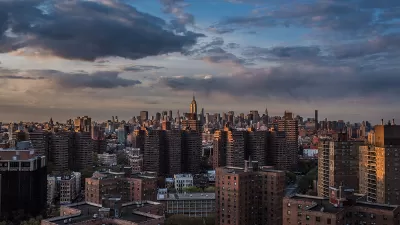New York City Mayor Bill de Blasio announced the details of the "Housing New York" plan this week. The plan will guide the de Blasio Administration toward its goal of creating 200,000 affordable housing units in the city.

"New York City will commit $8.2 billion in public funds to a 10-year housing plan that could transform the cityscape from Cypress Hills in Brooklyn to the shores of the Harlem River," according to an article by Mireya Navarro and Michael N. Grynbaum in the New York Times.
The $41.1 billion, ten-year plan will require "$2.9 billion in state and federal money and more than $30 billion the city expects to attract in private funds." That investment will earn the city 80,000 new affordable units while preserving 120,000 currently existing units.
Mayor de Blasio is quoted in the article describing the plan as, “a central pillar in the battle against inequality.”
Writing for The Architect's Newspaper, Henry Melcher adds details about the policy mechanisms included in the plan, as well their implications for the city's skyline. "As expected, one of the central pieces of de Blasio’s plan is 'mandatory inclusionary zoning,' which will require developers to include below market-rate units at rezoned sites."
Melcher shares more details from the report: "the City will also 're-examine parking requirements, zoning envelope constraints, and restrictions on the transferability of development rights.' It is also launching two programs to incentive development on vacant lots."
Melcher does the math and concludes, "De Blasio’s New York will likely be a denser New York," which, he adds, is likely to please the construction and architecture industries.
Stephen J. Miller, writing for Next City, also provides analysis of the plan, called the "Housing New York: A Five-Borough, Ten-Year Plan," which begins by comparing the new plan to Mayor de Blasio's campaign platform.
Miller finds that the growth of total housing in New York City under Mayor de Blasio's current housing proposals will equal the rate under Bloomberg—five percent over ten years.
Here, Miller details how Mayor de Blasio would spread funding among income groups: "Compared to the Bloomberg years, though, a much higher proportion of the new housing units created will be subsidized....De Blasio’s new-build affordable housing target is 60 percent higher than Bloomberg ended up with (and in two fewer years), even if it doesn’t quite measure up to what he promised on the campaign trail. And of those units, four times as many will be made available to the poorest class of working New Yorkers — which, for families of four, works out to those with incomes no greater than around $25,000 a year, with rents that don’t come near four digits."
FULL STORY: De Blasio Sets a 10-Year Plan for Housing, Putting the Focus on Affordability

Planetizen Federal Action Tracker
A weekly monitor of how Trump’s orders and actions are impacting planners and planning in America.

Restaurant Patios Were a Pandemic Win — Why Were They so Hard to Keep?
Social distancing requirements and changes in travel patterns prompted cities to pilot new uses for street and sidewalk space. Then it got complicated.

Map: Where Senate Republicans Want to Sell Your Public Lands
For public land advocates, the Senate Republicans’ proposal to sell millions of acres of public land in the West is “the biggest fight of their careers.”

Maui's Vacation Rental Debate Turns Ugly
Verbal attacks, misinformation campaigns and fistfights plague a high-stakes debate to convert thousands of vacation rentals into long-term housing.

San Francisco Suspends Traffic Calming Amidst Record Deaths
Citing “a challenging fiscal landscape,” the city will cease the program on the heels of 42 traffic deaths, including 24 pedestrians.

California Homeless Arrests, Citations Spike After Ruling
An investigation reveals that anti-homeless actions increased up to 500% after Grants Pass v. Johnson — even in cities claiming no policy change.
Urban Design for Planners 1: Software Tools
This six-course series explores essential urban design concepts using open source software and equips planners with the tools they need to participate fully in the urban design process.
Planning for Universal Design
Learn the tools for implementing Universal Design in planning regulations.
Heyer Gruel & Associates PA
JM Goldson LLC
Custer County Colorado
City of Camden Redevelopment Agency
City of Astoria
Transportation Research & Education Center (TREC) at Portland State University
Camden Redevelopment Agency
City of Claremont
Municipality of Princeton (NJ)




























